An Approach for Quantifying a Regional Haze Stress: Case Study in Three Cities of Taiwan
Abstract
1. Introduction
2. Materials and Methodology
2.1. Target Cities and Selected Representative Air Quality Monitoring Stations
2.2. Weighting Methods
3. Results and Discussion
3.1. Establishing Regional HSIs
3.2. Spatial and Temporal Variations in PM2.5, RH, and ([O3] + [NO2])
3.3. Comparison Between the Three Weighting Methods
3.4. Hourly Haze Stress
3.5. Daily Haze Stress
3.6. Monthly Haze Stress
3.7. Yearly Haze Stress
3.8. Quantifying People’s Feelings of Haze Stress
4. Conclusions
Author Contributions
Funding
Conflicts of Interest
References
- Stieb, D.M.; Burnett, R.T.; Smith-Doiron, M.; Brion, O.; Shin, H.H.; Economou, V. A New Multipollutant, No-Threshold Air Quality Health Index Based on Short-Term Associations Observed in Daily Time-Series Analyses. J. Air Waste Manag. Assoc. 2008, 58, 435–450. [Google Scholar] [CrossRef] [PubMed]
- Perlmutt, L.D.; Cromar, K.R. Comparing associations of respiratory risk for the EPA Air Quality Index and health-based air quality indices. Atmos. Environ. 2019, 202, 1–7. [Google Scholar] [CrossRef]
- Plaia, A.; Di Salvo, F.; Ruggieri, M.; Agró, G. A Multisite-Multipollutant Air Quality Index. Atmos. Environ. 2013, 70, 387–391. [Google Scholar] [CrossRef]
- Thach, T.Q.; Tsang, H.; Cao, P.; Ho, L.-M. A novel method to construct an air quality index based on air pollution profiles. Int. J. Hyg. Environ. Health 2018, 221, 17–26. [Google Scholar] [CrossRef]
- Gorai, A.K.; Kanchan; Upadhyay, A.; Tuluri, F.; Goyal, P.; Tchounwou, P.B. An innovative approach for determination of air quality health index. Sci. Total Environ. 2015, 533, 495–505. [Google Scholar] [CrossRef]
- Stergiopoulou, A.; Katavoutas, G.; Samoli, E.; Dimakopoulou, K.; Papageorgiou, I.; Karagianni, P.; Flocas, H.; Katsouyanni, K. Assessing the associations of daily respiratory symptoms and lung function in schoolchildren using an Air Quality Index for ozone: Results from the RESPOZE panel study in Athens, Greece. Sci. Total Environ. 2018, 633, 492–499. [Google Scholar] [CrossRef]
- Huang, Q.; Huang, J.; Yang, X.; Fang, C.; Liang, Y. Quantifying the seasonal contribution of coupling urban land use types on Urban Heat Island using Land Contribution Index: A case study in Wuhan, China. Sustain. Cities Soc. 2019, 44, 666–675. [Google Scholar] [CrossRef]
- Bagieński, Z. Traffic air quality index. Sci. Total Environ. 2015, 505, 606–614. [Google Scholar] [CrossRef]
- Baumüller, J.; Reuter, U. The Valuation of Total Air Pollution by Means of an Air Quality Index. Staub Reinhalt. Luft 1995, 55, 137–141. [Google Scholar]
- Baylis, P.; Obradovich, N.; Kryvasheyeu, Y.; Chen, H.; Coviello, L.; Moro, E.; Cebrian, M.; Fowler, J.H. Weather impacts expressed sentiment. PLoS ONE 2018, 13, e0195750. [Google Scholar] [CrossRef]
- Sun, X.; Yang, W.; Sun, T.; Wang, Y.P. Negative Emotion under Haze: An Investigation Based on the Microblog and Weather Records of Tianjin, China. Int. J. Environ. Res. Public Health 2018, 16, 86. [Google Scholar] [CrossRef] [PubMed]
- Kim, K.-H.; Kabir, E.; Kabir, S. A review on the human health impact of airborne particulate matter. Environ. Int. 2015, 74, 136–143. [Google Scholar] [CrossRef] [PubMed]
- Yaacob, W.F.W.; Noor, N.S.M.; Bakar, N.I.C.A.; Zin, N.A.M.; Taib, F. The impact of haze on the adolescent’s acute respiratory disease: A single institution study. J. Acute Dis. 2016, 5, 227–231. [Google Scholar] [CrossRef]
- Ramakreshnan, L.; Aghamohammadi, N.; Fong, C.S.; Bulgiba, A.M.; Zaki, R.; Wong, L.P.; Sulaiman, N.M. Haze and health impacts in ASEAN countries: A systematic review. Environ. Sci. Pollut. Res. 2017, 25, 2096–2111. [Google Scholar] [CrossRef] [PubMed]
- Chameides, W.L.; Yu, H.; Liu, S.C.; Bergin, M.; Zhou, X.; Mearns, L.; Wang, G.; Kiang, C.S.; Saylor, R.D.; Luo, C.; et al. Case study of the effects of atmospheric aerosols and regional haze on agriculture: An opportunity to enhance crop yields in China through emission controls? Proc. Natl. Acad. Sci. USA 1999, 96, 13626–13633. [Google Scholar] [CrossRef]
- Anaman, K.A.; Looi, C.N. Economic Impact of Haze-Related Air Pollution on the Tourism Industry in Brunei Darussalam11This study was sponsored by the University of Brunei Darussalam. Econ. Anal. Policy 2000, 30, 133–143. [Google Scholar] [CrossRef]
- Manan, N.A.; Manaf, M.R.A.; Hod, R. The Malaysia haze and its health economic impact: A literature review. Malays. J. Public Health Med. 2018, 18, 38–45. [Google Scholar]
- Lee, R.S.; Craun, C.; Robinson, M.; Phaneuf, M. Evaluating the Impacts of Haze on Air Traffic Operations. In Proceedings of the 92nd American Meteorological Society Annual Meeting, New Orleans, LA, USA, 21–26 January 2012. [Google Scholar]
- Lin, G.-Z.; Li, L.; Song, Y.-F.; Zhou, Y.-X.; Shen, S.-Q.; Ou, C.-Q. The impact of ambient air pollution on suicide mortality: A case-crossover study in Guangzhou, China. Environ. Health 2016, 15, 1–8. [Google Scholar] [CrossRef]
- Murena, F. Measuring air quality over large urban areas: Development and application of an air pollution index at the urban area of Naples. Atmos. Environ. 2004, 38, 6195–6202. [Google Scholar] [CrossRef]
- Mayer, H.; Kalberlah, F.; Ahrens, D.; Reuter, U. Analysis of indices for assessing the air. Gefahrst. Reinhalt. Luft 2002, 62, 177–183. [Google Scholar]
- Mayer, H.; Makra, L.; Kalberlah, F.; Ahrens, D.; Reuter, U. Air stress and air quality indices. Meteorol. Z. 2004, 13, 395–403. [Google Scholar] [CrossRef]
- Kassomenos, P.A.; Kelessis, A.G.; Petrakakis, M.; Zoumakis, N.M.; Christidis, T.; Paschalidou, A. Air quality assessment in a heavily polluted urban Mediterranean environment through air quality indices. Ecol. Indic. 2012, 18, 259–268. [Google Scholar] [CrossRef]
- Kassomenos, P.; Skouloudis, A.; Lykoudis, S.; Flocas, H. “Air-quality indicators” for uniform indexing of atmospheric pollution over large metropolitan areas. Atmos. Environ. 1999, 33, 1861–1879. [Google Scholar] [CrossRef]
- Guo, S.; Hu, M.; Zamora, M.L.; Peng, J.; Shang, D.; Zheng, J.; Du, Z.; Wu, Z.; Shao, M.; Zeng, L.; et al. Elucidating severe urban haze formation in China. Proc. Natl. Acad. Sci. USA 2014, 111, 17373–17378. [Google Scholar] [CrossRef] [PubMed]
- Norela, S.; Saidah, M.; Mahmud, M. Chemical composition of the haze in Malaysia 2005. Atmos. Environ. 2013, 77, 1005–1010. [Google Scholar] [CrossRef]
- Song, J.-M.; Bu, J.-O.; Yang, S.-H.; Lee, J.-Y.; Kim, W.-H.; Kang, C.-H. Influences of Asian Dust, Haze, and Mist Events on Chemical Compositions of Fine Particulate Matters at Gosan Site, Jeju Island in 2014. J. Korean Soc. Atmos. Environ. 2016, 32, 67–81. [Google Scholar] [CrossRef][Green Version]
- Murillo, J.H.; Marin, J.F.R.; Roman, S.R.; Guerrero, V.H.B.; Arias, D.S.; Ramos, A.C.; Gonzalez, B.C.; Baumgardne, D.G. Temporal and spatial variations in organic and elemental carbon concentrations in PM10/PM2.5 in the metropolitan area of Costa Rica, Central America. Atmos. Pollut. Res. 2013, 4, 53–63. [Google Scholar] [CrossRef]
- Zhong, S.; Zhang, L.; Jiang, X.; Gao, P. Comparison of chemical composition and airborne bacterial community structure in PM2.5 during haze and non-haze days in the winter in Guilin, China. Sci. Total Environ. 2019, 655, 202–210. [Google Scholar] [CrossRef]
- Cheng, Z.; Wang, S.; Jiang, J.; Fu, Q.; Chen, C.; Xu, B.; Yu, J.; Fu, X.; Hao, J. Long-term trend of haze pollution and impact of particulate matter in the Yangtze River Delta, China. Environ. Pollut. 2013, 182, 101–110. [Google Scholar] [CrossRef]
- Wang, L.; Xu, J.; Yang, J.; Zhao, X.; Wei, W.; Cheng, D.; Pan, X.; Su, J. Understanding haze pollution over the southern Hebei area of China using the CMAQ model. Atmos. Environ. 2012, 56, 69–79. [Google Scholar] [CrossRef]
- Hunova, I. Spatial interpretation of ambient air quality for the territory of the Czech Republic. Environ. Pollut. 2001, 112, 107–119. [Google Scholar] [CrossRef]
- Kim, H.; Collier, S.; Ge, X.; Xu, J.; Sun, Y.; Jiang, W.; Wang, Y.; Herckes, P.; Zhang, Q. Chemical processing of water-soluble species and formation of secondary organic aerosol in fogs. Atmos. Environ. 2019, 200, 158–166. [Google Scholar] [CrossRef]
- Rösch, C.; Wissenbach, D.K.; Franck, U.; Wendisch, M.; Schlink, U. Degradation of indoor limonene by outdoor ozone: A cascade of secondary organic aerosols. Environ. Pollut. 2017, 226, 463–472. [Google Scholar] [CrossRef] [PubMed]
- Zhang, P.; Huang, J.; Shu, J.; Yang, B. Comparison of secondary organic aerosol (SOA) formation during o-, m-, and p-xylene photooxidation. Environ. Pollut. 2019, 245, 20–28. [Google Scholar] [CrossRef]
- Chen, T.; Liu, Y.; Chu, B.; Liu, C.; Liu, J.; Ge, Y.; Ma, Q.; Ma, J.; He, H. Differences of the oxidation process and secondary organic aerosol formation at low and high precursor concentrations. J. Environ. Sci. 2019, 79, 256–263. [Google Scholar] [CrossRef]
- Ren, Y.Q.; Wang, G.; Li, J.J.; Wu, C.; Cao, C.; Li, J.; Wang, J.Y.; Ge, S.S.; Xie, Y.N.; Li, X.R.; et al. Evolution of aerosol chemistry in Xi’an during the spring dust storm periods: Implications for heterogeneous formation of secondary organic aerosols on the dust surface. Chemosphere 2019, 215, 413–421. [Google Scholar] [CrossRef]
- Zheng, B.; Zhang, Q.; Zhang, Y.; He, K.B.; Wang, K.; Zheng, G.J.; Duan, F.-K.; Ma, Y.L.; Kimoto, T. Heterogeneous chemistry: A mechanism missing in current models to explain secondary inorganic aerosol formation during the January 2013 haze episode in North China. Atmos. Chem. Phys. Discuss. 2015, 15, 2031–2049. [Google Scholar] [CrossRef]
- Seinfeld, J.H.; Pandis, S.N. Atmospheric Chemistry and Physics: From Air Pollution to Climate Change, 2nd ed.; John Wiley and Sons: Hoboken, NJ, USA, 2006; pp. 628–678. [Google Scholar]
- Kroll, J.H.; Seinfeld, J.H. Chemistry of secondary organic aerosol: Formation and evolution of low-volatility organics in the atmosphere. Atmos. Environ. 2008, 42, 3593–3624. [Google Scholar] [CrossRef]
- Herndon, S.C.; Onasch, T.B.; Wood, E.C.; Kroll, J.H.; Canagaratna, M.R.; Jayne, J.T.; Zavala, M.A.; Knighton, W.B.; Mazzoleni, C.; Dubey, M.K.; et al. Correlation of secondary organic aerosol with odd oxygen in Mexico City. Geophys. Res. Lett. 2008, 35, 15804. [Google Scholar] [CrossRef]
- Wood, E.C.; Canagaratna, M.R.; Herndon, S.C.; Onasch, T.B.; Kolb, C.E.; Worsnop, D.R.; Kroll, J.H.; Knighton, W.B.; Seila, R.; Zavala, M.; et al. Investigation of the correlation between odd oxygen and secondary organic aerosol in Mexico City and Houston. Atmos. Chem. Phys. Discuss. 2010, 10, 8947–8968. [Google Scholar] [CrossRef]
- Hu, W.; Hu, M.; Hu, W.; Jimenez, J.L.; Yuan, B.; Chen, W.; Wang, M.; Wu, Y.; Chen, C.; Wang, Z.; et al. Chemical composition, sources, and aging process of submicron aerosols in Beijing: Contrast between summer and winter. J. Geophys. Res. Atmos. 2016, 121, 1955–1977. [Google Scholar] [CrossRef]
- Zhu, W.; Xie, J.; Cheng, Z.; Sheng-Rong, L.; Luo, L.; Hu, W.; Zheng, J.; Yan, N.; Brooks, B. Influence of chemical size distribution on optical properties for ambient submicron particles during severe haze events. Atmos. Environ. 2018, 191, 162–171. [Google Scholar] [CrossRef]
- Lin, F.-C.; Lu, S.-H.; Liang, C.-J.; Chen, Y.-H.; Liang, J.-J. Quantifying source apportionment for ambient haze: An image haze extraction approach with air quality monitoring data. Environ. Res. 2020, 184, 109216. [Google Scholar] [CrossRef] [PubMed]
- Toftum, J.; Jørgensen, A.S.; Fanger, P. Upper limits of air humidity for preventing warm respiratory discomfort. Energy Build. 1998, 28, 15–23. [Google Scholar] [CrossRef]
- Peng, Y.; Wang, H.; Hou, M.; Jiang, T.; Zhang, M.; Zhao, T.; Che, H. Improved method of visibility parameterization focusing on high humidity and aerosol concentrations during fog-haze events: Application in the GRAPES_CAUCE model in Jing-Jin-Ji, China. Atmos. Environ. 2020, 222, 117139. [Google Scholar] [CrossRef]
- Liu, F.; Tan, Q.; Jiang, X.; Yang, F.; Jiang, W. Effects of relative humidity and PM2.5 chemical compositions on visibility impairment in Chengdu, China. J. Environ. Sci. 2019, 86, 15–23. [Google Scholar] [CrossRef]
- Long, S.; Zeng, J.; Lingling, C.; Bao, L.; Cao, L.; Liu, K.; Xu, L.; Lin, J.; Liu, W.; Wang, G.-H.; et al. Characteristics of secondary inorganic aerosol and sulfate species in size-fractionated aerosol particles in Shanghai. J. Environ. Sci. 2014, 26, 1040–1051. [Google Scholar] [CrossRef]
- Du, J.; Zhang, X.; Huang, T.; Gao, H.; Mo, J.; Mao, X.; Ma, J. Removal of PM2.5 and secondary inorganic aerosols in the North China Plain by dry deposition. Sci. Total Environ. 2019, 651, 2312–2322. [Google Scholar] [CrossRef]
- Behera, S.N.; Sharma, M. Degradation of SO2, NO2 and NH3 leading to formation of secondary inorganic aerosols: An environmental chamber study. Atmos. Environ. 2011, 45, 4015–4024. [Google Scholar] [CrossRef]
- Liu, X.; Zhao, W.; Meng, M.; Fu, Z.; Xu, L.; Zha, Y.; Yue, J.; Zhang, S.; Zhang, J. Comparative effects of simulated acid rain of different ratios of SO42− to NO3− on fine root in subtropical plantation of China. Sci. Total Environ. 2018, 618, 336–346. [Google Scholar] [CrossRef]
- Ma, Q.; Wu, Y.; Tao, J.; Xia, Y.; Liu, X.; Zhang, D.; Chang, A.; Zhang, X.; Zhang, R. Variations of Chemical Composition and Source Apportionment of PM2.5 during Winter Haze Episodes in Beijing. Aerosol Air Qual. Res. 2017, 17, 2791–2803. [Google Scholar] [CrossRef]
- Ma, Q.; Wu, Y.; Fu, S.; Zhang, D.; Han, Z.; Zhang, R. Pollution severity-dependent aerosol light scattering enhanced by inorganic species formation in Beijing haze. Sci. Total Environ. 2020, 719, 137545. [Google Scholar] [CrossRef] [PubMed]
- Salau, O.R. The changes in temperature and relative humidity in Lagos State, Nigeria. World Sci. News 2016, 49, 295–306. [Google Scholar]
- Maughan, R.J.; Otani, H.; Watson, P. Influence of relative humidity on prolonged exercise capacity in a warm environment. Eur. J. Appl. Physiol. 2012, 112, 2313–2321. [Google Scholar] [CrossRef]
- Licina, D.; Sekhar, C. Energy and water conservation from air handling unit condensate in hot and humid climates. Energy Build. 2012, 45, 257–263. [Google Scholar] [CrossRef]
- Fan, C.; Liu, F.; Zhao, X.; Ma, Y.; Yang, F.; Chang, Z.; Xiao, X. An alternative comprehensive index to quantify the interactive effect of temperature and relative humidity on hand, foot and mouth disease: A two-stage time series study including 143 cities in mainland China. Sci. Total Environ. 2020, 740, 140106. [Google Scholar] [CrossRef]
- Xu, R.; Xiong, X.; Abramson, M.J.; Li, S.; Guo, Y. Ambient temperature and intentional homicide: A multi-city case-crossover study in the US. Environ. Int. 2020, 143, 105992. [Google Scholar] [CrossRef]
- Li, C.; Ma, X.; Fu, T.; Guan, S. Does public concern over haze pollution matter? Evidence from Beijing-Tianjin-Hebei region, China. Sci. Total Environ. 2021, 755, 142397. [Google Scholar] [CrossRef]
- Yang, J.; Qu, S.; Liu, M.; Liu, X.; Gao, Q.; He, W.; Ji, J.S.; Bi, J. Gray cityscape caused by particulate matter pollution hampers human stress recovery. J. Clean. Prod. 2021, 279, 123215. [Google Scholar] [CrossRef]
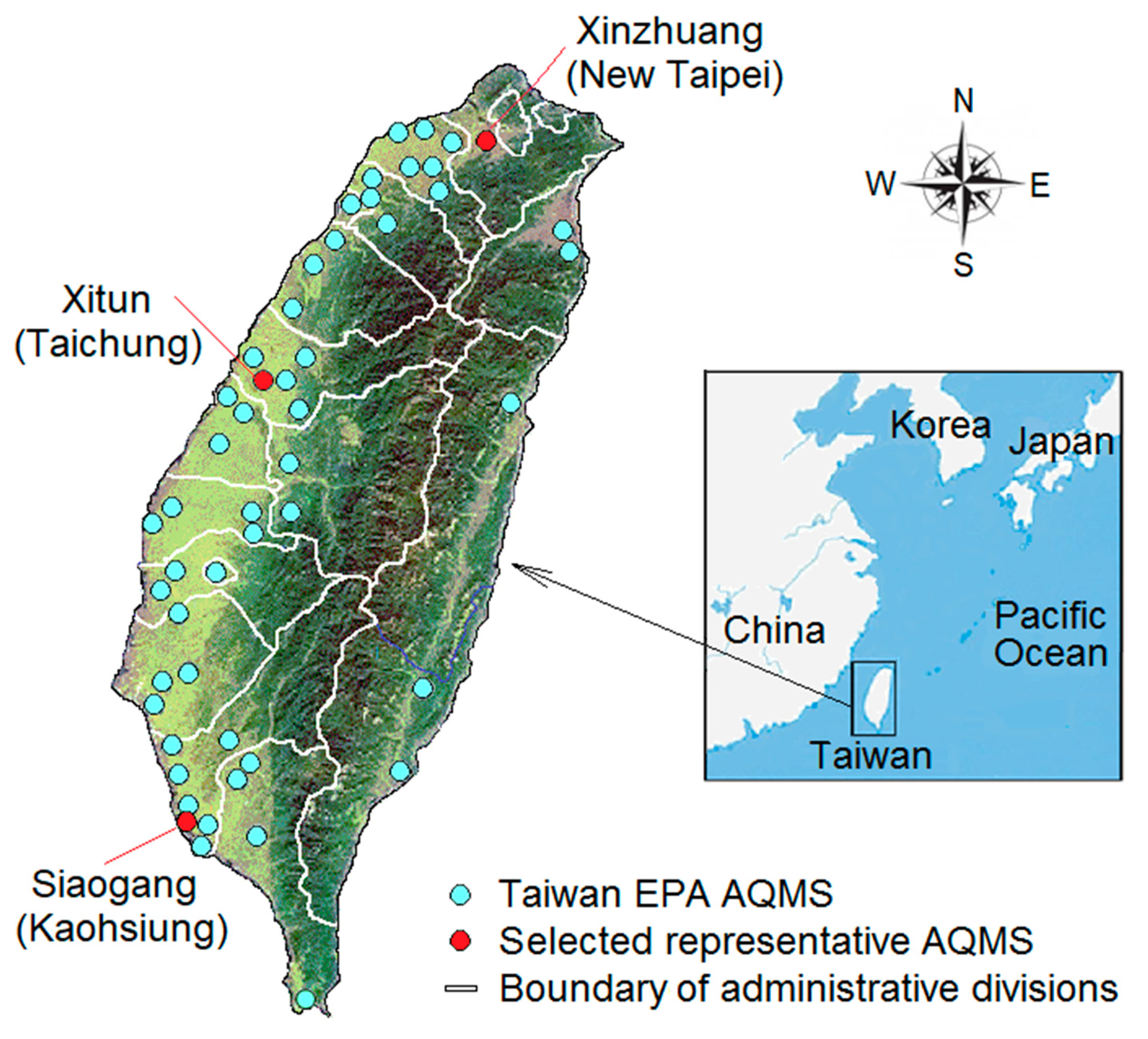

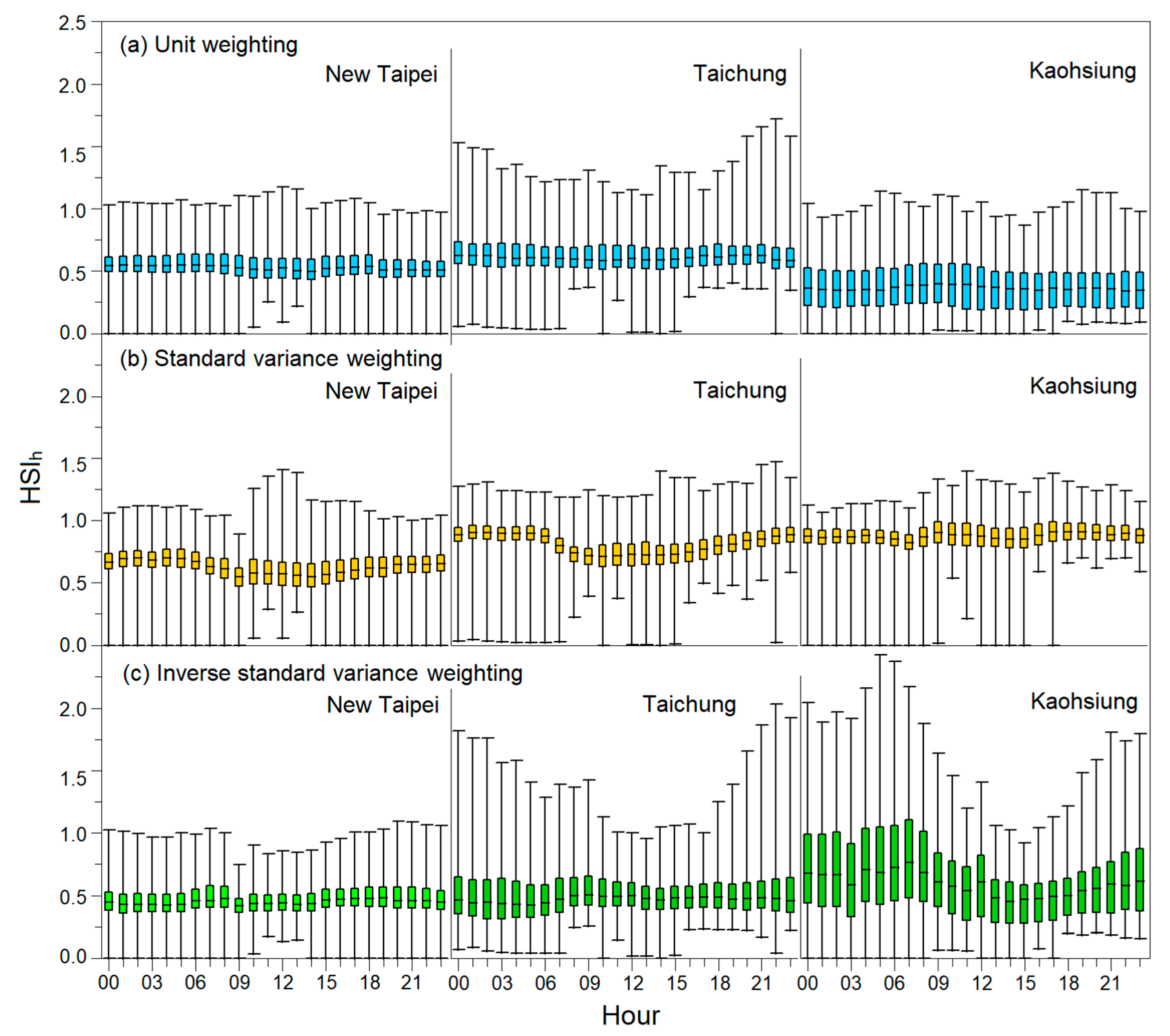
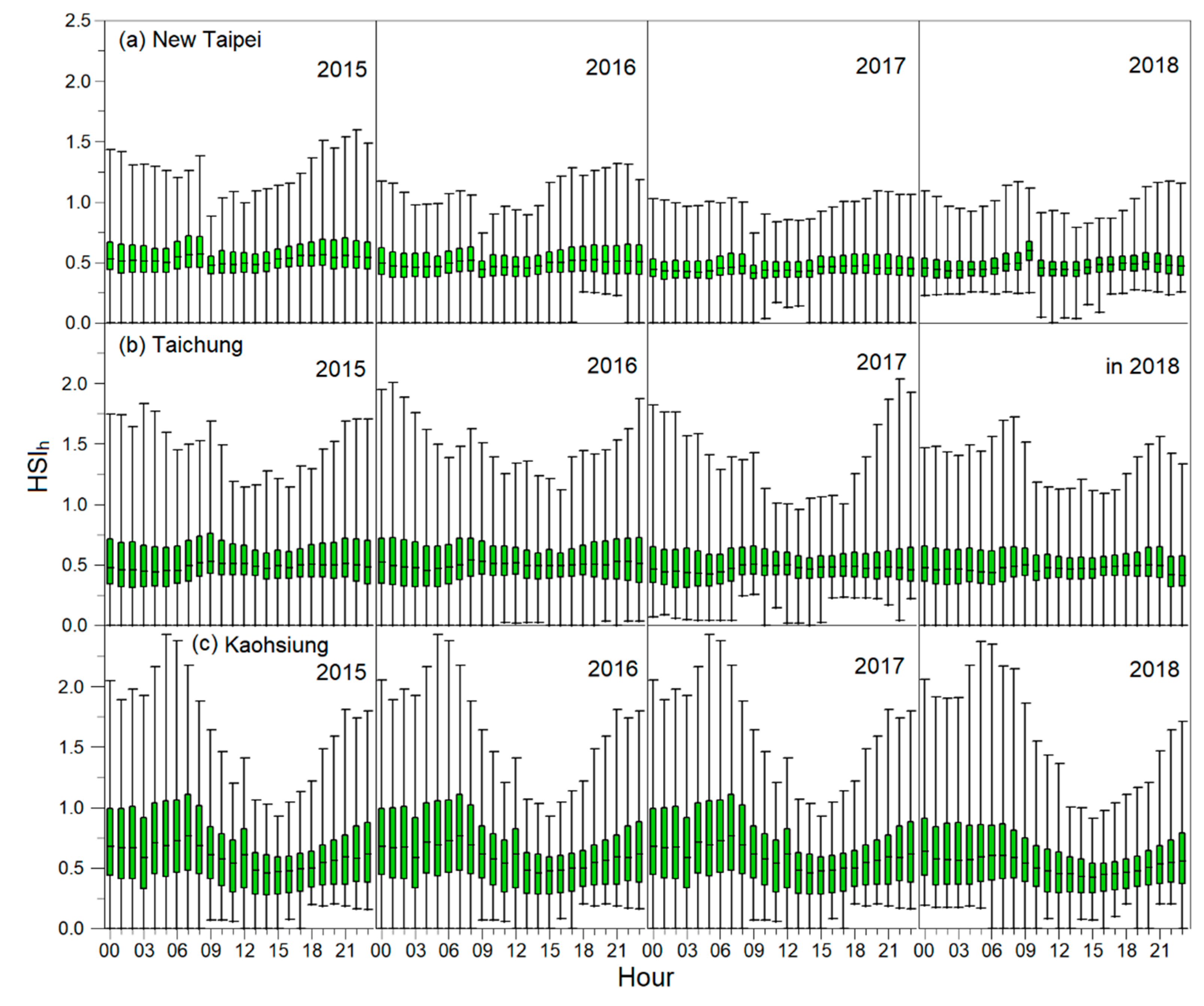

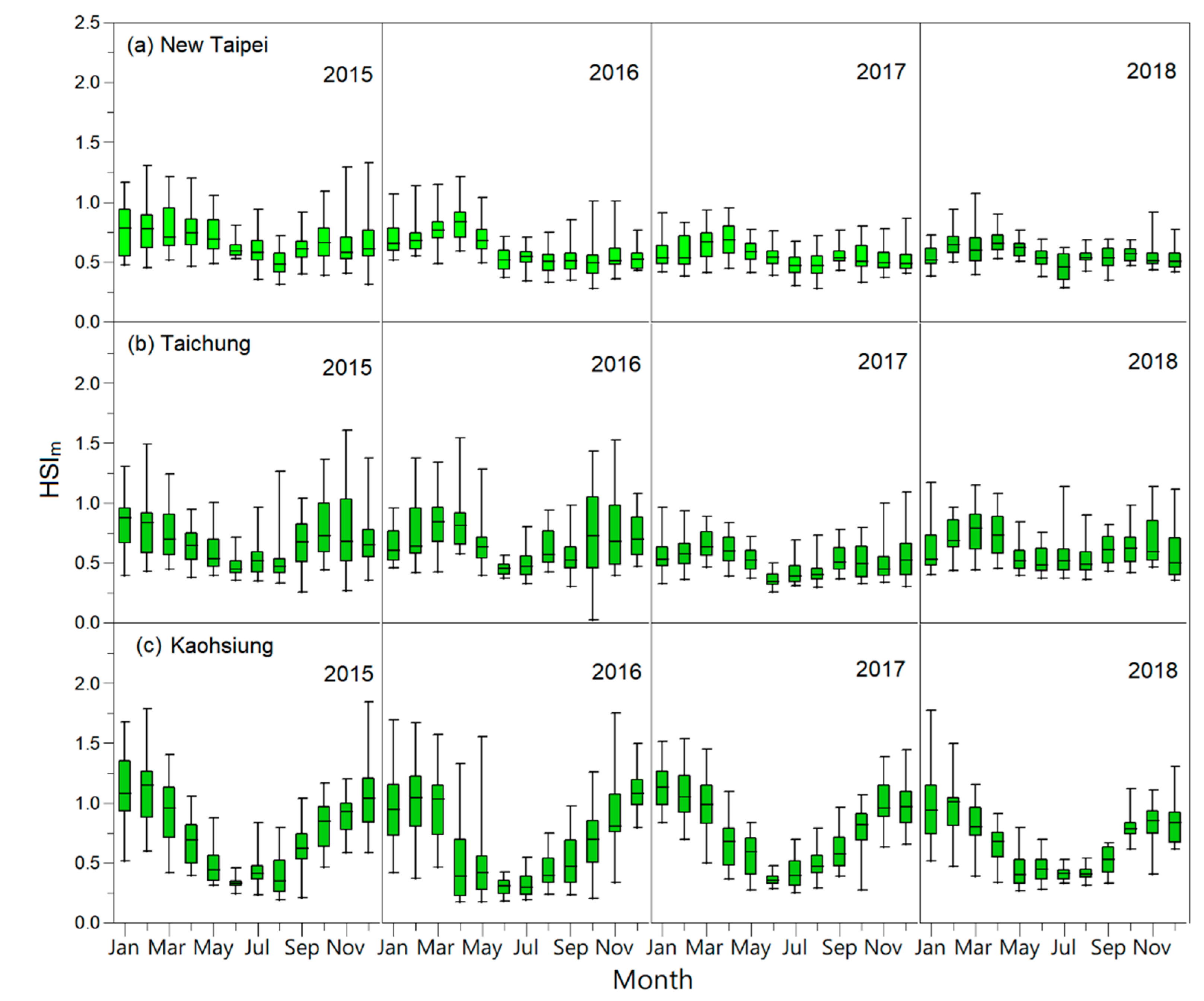
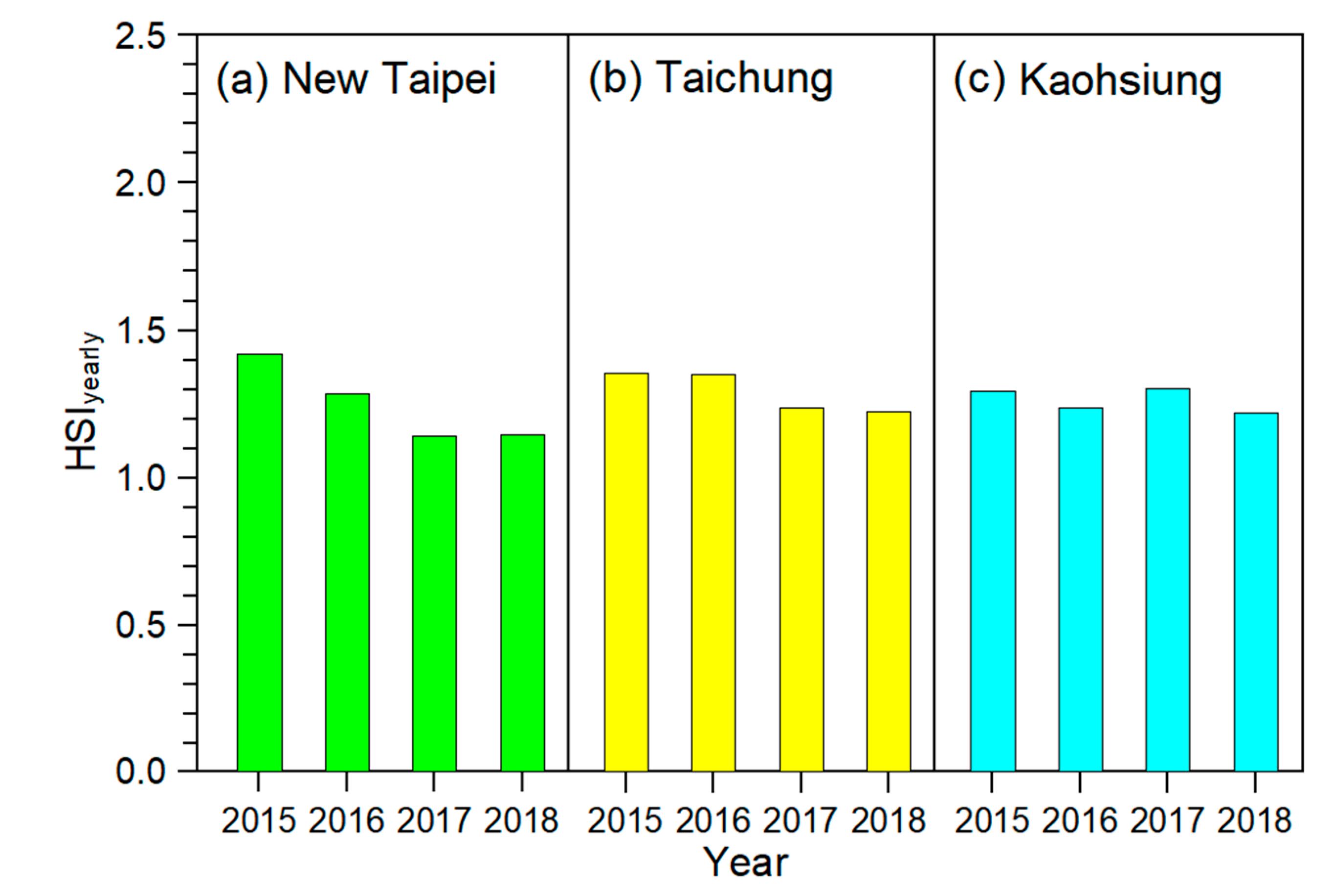
| AQI Category (Range) | Particulate Matters (μg m−3) | O3 (ppb) | NO2 (ppb) [1 h] | CO (ppm) [8 h] | SO2 (ppb) [24 h] | ||
|---|---|---|---|---|---|---|---|
| PM10 [24 h] | PM2.5 [24 h] | [8 h] (2) | [1 h] (1) | ||||
| Good (0–50) | 0–54 | 0.0–15.4 | 0–54 | – | 0–53 | 0–4.4 | 0–35 |
| Moderate (51–100) | 55–125 | 15.5–35.4 | 55–70 | – | 54–100 | 4.5–9.4 | 36–75 |
| Unhealthy for sensitive groups (101–150) | 126–254 | 35.5–54.4 | 71–85 | 125–164 | 101–360 | 9.5–12.4 | 76–185 |
| Unhealthy (151–200) | 255–354 | 54.5–150.4 | 86–105 | 165–204 | 361–649 | 12.5–15.4 | 186–304 |
| Very unhealthy (201–300) | 355–424 | 150.5–250.4 | 106–200 | 205–404 | 650–1249 | 15.5–30.4 | 305–604 |
| Hazardous (301–500) | 425–504 | 250.5–500.4 | – | 405–604 | 1250–2049 | 30.5–50.4 | 605–1004 |
| Cities | 2015 | 2016 | 2017 | 2018 | ||||
|---|---|---|---|---|---|---|---|---|
| Mean | SD | Mean | SD | Mean | SD | Mean | SD | |
| Hourly HIS | ||||||||
| New Taipei | 0.56 | 0.19 | 0.51 | 0.16 | 0.47 | 0.13 | 0.49 | 0.12 |
| Taichung | 0.55 | 0.25 | 0.55 | 0.24 | 0.51 | 0.19 | 0.51 | 0.19 |
| Kaohsiung | 0.60 | 0.34 | 0.55 | 0.38 | 0.62 | 0.33 | 0.56 | 0.27 |
| Daily HSI | ||||||||
| New Taipei | 0.68 | 0.19 | 0.62 | 0.16 | 0.56 | 0.13 | 0.57 | 0.11 |
| Taichung | 0.68 | 0.25 | 0.68 | 0.24 | 0.67 | 0.18 | 0.62 | 0.18 |
| Kaohsiung | 0.74 | 0.34 | 0.68 | 0.38 | 0.75 | 0.31 | 0.67 | 0.26 |
| Monthly HSI | ||||||||
| New Taipei | 0.87 | 0.12 | 0.79 | 0.16 | 0.71 | 0.09 | 0.71 | 0.09 |
| Taichung | 0.83 | 0.16 | 0.83 | 0.17 | 0.76 | 0.14 | 0.74 | 0.12 |
| Kaohsiung | 0.97 | 0.44 | 0.89 | 0.45 | 1.00 | 0.40 | 0.86 | 0.34 |
| HSI | 0.0–0.5 | 0.6–1.0 | 1.1–1.5 | 1.6–2.0 | >2.0 |
|---|---|---|---|---|---|
| Descriptor | Good | Fair | Anxious | Uncomfortable | Very uncomfortable |
| People’s Feelings | New Taipei | Taichung | Kaohsiung | ||||||
|---|---|---|---|---|---|---|---|---|---|
| Hourly | Daily | Monthly | Hourly | Daily | Monthly | Hourly | Daily | Monthly | |
| 2015 | |||||||||
| Good | 43.1 | 12.9 | 0.0 | 52.4 | 27.4 | 0.0 | 47.8 | 32.3 | 16.7 |
| Fair | 53.9 | 80.3 | 75.0 | 41.7 | 61.6 | 83.3 | 38.7 | 44.4 | 33.3 |
| Anxious | 3.0 | 6.8 | 25.0 | 5.5 | 10.7 | 16.7 | 10.7 | 21.4 | 33.3 |
| Uncomfortable | 0.0 | 0.0 | 0.0 | 0.3 | 0.3 | 0.0 | 2.3 | 1.9 | 16.7 |
| Very uncomfortable | 0.0 | 0.0 | 0.0 | 0.0 | 0.0 | 0.0 | 0.5 | 0.0 | 0.0 |
| 2016 | |||||||||
| Good | 53.3 | 24.6 | 0.0 | 49.6 | 27.0 | 0.0 | 54.4 | 39.9 | 25.0 |
| Fair | 45.7 | 72.7 | 83.3 | 45.3 | 63.7 | 83.3 | 32.8 | 37.4 | 33.3 |
| Anxious | 1.0 | 2.7 | 16.7 | 4.8 | 8.7 | 16.7 | 9.9 | 20.2 | 33.3 |
| Uncomfortable | 0.0 | 0.0 | 0.0 | 0.4 | 0.5 | 0.0 | 2.7 | 2.5 | 8.3 |
| Very uncomfortable | 0.0 | 0.0 | 0.0 | 0.0 | 0.0 | 0.0 | 0.2 | 0.0 | 0.0 |
| 2017 | |||||||||
| Good | 67.5 | 34.5 | 0.0 | 56.3 | 31.2 | 8.3 | 41.7 | 28.2 | 16.7 |
| Fair | 32.2 | 65.5 | 100.0 | 41.6 | 63.8 | 91.7 | 45.2 | 49.9 | 33.3 |
| Anxious | 0.3 | 0.0 | 0.0 | 2.0 | 4.9 | 0.0 | 11.5 | 21.4 | 41.7 |
| Uncomfortable | 0.0 | 0.0 | 0.0 | 0.1 | 0.0 | 0.0 | 1.5 | 0.5 | 8.3 |
| Very uncomfortable | 0.0 | 0.0 | 0.0 | 0.0 | 0.0 | 0.0 | 0.1 | 0.0 | 0.0 |
| 2018 | |||||||||
| Good | 60.6 | 25.5 | 0.0 | 56.6 | 30.4 | 0.0 | 48.2 | 33.2 | 16.7 |
| Fair | 39.1 | 74.2 | 100.0 | 41.2 | 65.5 | 100.0 | 44.8 | 54.5 | 33.3 |
| Anxious | 0.3 | 0.3 | 0.0 | 2.1 | 4.1 | 0.0 | 6.3 | 11.8 | 50.0 |
| Uncomfortable | 0.0 | 0.0 | 0.0 | 0.1 | 0.0 | 0.0 | 0.7 | 0.5 | 0.0 |
| Very uncomfortable | 0.0 | 0.0 | 0.0 | 0.0 | 0.0 | 0.0 | 0.1 | 0.0 | 0.0 |
Publisher’s Note: MDPI stays neutral with regard to jurisdictional claims in published maps and institutional affiliations. |
© 2020 by the authors. Licensee MDPI, Basel, Switzerland. This article is an open access article distributed under the terms and conditions of the Creative Commons Attribution (CC BY) license (http://creativecommons.org/licenses/by/4.0/).
Share and Cite
Liang, C.-J.; Liang, J.-J.; Lin, F.-C.; Jheng, C.-W. An Approach for Quantifying a Regional Haze Stress: Case Study in Three Cities of Taiwan. Atmosphere 2020, 11, 1236. https://doi.org/10.3390/atmos11111236
Liang C-J, Liang J-J, Lin F-C, Jheng C-W. An Approach for Quantifying a Regional Haze Stress: Case Study in Three Cities of Taiwan. Atmosphere. 2020; 11(11):1236. https://doi.org/10.3390/atmos11111236
Chicago/Turabian StyleLiang, Chen-Jui, Jeng-Jong Liang, Feng-Cheng Lin, and Chiao-Wun Jheng. 2020. "An Approach for Quantifying a Regional Haze Stress: Case Study in Three Cities of Taiwan" Atmosphere 11, no. 11: 1236. https://doi.org/10.3390/atmos11111236
APA StyleLiang, C.-J., Liang, J.-J., Lin, F.-C., & Jheng, C.-W. (2020). An Approach for Quantifying a Regional Haze Stress: Case Study in Three Cities of Taiwan. Atmosphere, 11(11), 1236. https://doi.org/10.3390/atmos11111236








